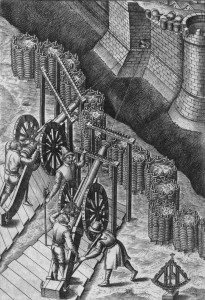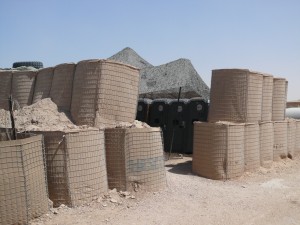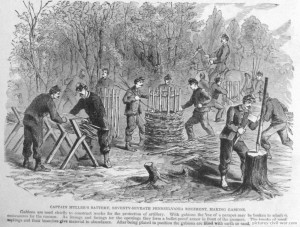There you are looking to sand bag you home in preparation for the impending doom be it bullets or rain drops when surprise, surprise…you don’t have a pallet of empty sandbags. You approach your wife and she gives you “the look” as you bring up pillow cases as an alternative… wives just don’t look at survival the way we do; it’s not like a rolled up t-shirt isn’t a perfectly good pillow substitute. So now what do you do? Let me take a moment to share a little history. Those of you who have served in combat over the last decade know these well; though you have been calling them HESCO barriers for some time.
A gabion (from Italian gabbione meaning “big cage”; from Italian gabbia and Latin cavea meaning “cage”) is a cage, cylinder, or box filled with rocks, concrete, or sometimes sand and soil for use in civil engineering, road building, and military applications. For erosion control, caged riprap is used. For dams or in foundation construction, cylindrical metal structures are used. In a military context, earth- or sand-filled gabions are used to protect artillery crews from enemy fire.
In the medieval era, gabions were round cages with open tops and bottoms, made from wickerwork and filled with earth for use as military fortifications. These early military gabions were used to protect field artillery gunners. The wickerwork cylinders were light and could be carried relatively conveniently in the ammunition train, particularly if they were made in several diameters to fit one inside another. At the site of use in the field, they could be stood on end, staked in position, and filled with soil to form an effective wall around the gun. Today, gabions are often used to protect forward operating bases (FOBs) against explosive, fragmentary, indirect fires such as mortar or artillery fire. Examples of areas within a FOB that make extensive use of gabions would be sleeping quarters, mess halls, or any place where there will be a large concentration of unprotected soldiers.
If you look in the history books, you will see gabions come into use about the same time gunpowder cannons do. And with an open eye you will see these used clear into the present in the form of commercial wire baskets. As far as I can tell the wicker style gabions were used into WW II for artillery emplacements by the Germans; although I haven’t found any evidence of the US using them at that time; it seems we had plenty of sand bags.
On the civilian side the most common civil engineering use of gabions is to stabilize shorelines, stream banks or slopes against erosion. Other uses include retaining walls, temporary floodwalls, silt filtration from runoff, for small or temporary/permanent dams, river training, or channel lining. They may be used to direct the force of a flow of flood water around a vulnerable structure. Gabions are also used as fish screens on small streams.
Now this doesn’t mean you have to get out there with a hatchet and a pocket knife and start cutting twigs. Do you have fence posts and chicken wire or other types of fencing? Do you have plastic sheeting that can go inside your quickly erected cages? Use your imagination and check out what you have at your disposal. Have fun and keep this in the recesses of your brain as a possible life saver.
Jon






Hi, I was wondering about the origin of the two sketches of gabions, i.e. the first and third of the illustrations?